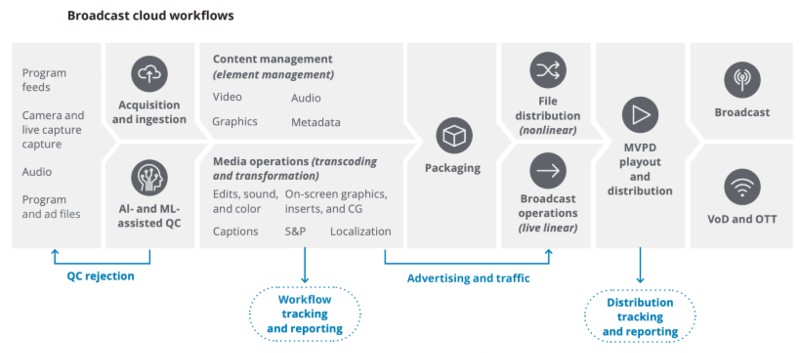BCS Stories
Transitioning to the cloud is inevitable

The pandemic has hastened the media and entertainment (M&E) industry’s adoption of cloud broadcast workflow and operations. Most organisations have successfully reimagined and reinvented the way they work. The cloud allows operators to deploy direct-to-consumer models and more varied monetization tactics. With cloud, operators can also embrace Artificial Intelligence and Machine Learning to gain new levels of elasticity and scalability.
With cloud continuing to gain acceptance with M&E companies, there is also a growing trend of adopting a combination of cloud-based computing platforms and everything-as-a-service (XaaS) models, claims Deloitte. “Increasingly, robust cloud and XaaS solutions have been able to diminish traditional industry resistance to cloud because they can deliver a range of critical capabilities,” says its report, The case for M&E cloud: Moving to fourth-generation broadcast infrastructure.
For instance, on-premises, outsourced, and hybrid cloud models give broadcast engineers and media technicians more direct control of operations while maintaining the flexibility and cost-sensitivity of each application or data set.
At a time when media organizations around the world continue to be besieged by cyberattacks, cloud security is recognized as a shared responsibility of companies and cloud providers. Both organizations are carefully managing and monitoring cloud environments to stay ahead of potential cyberattacks. Drawing on findings from security solutions provider Exabeam, Deloitte highlighted that almost half (44%) of organizations are using cloud-based security products to protect their data in a bid to mitigate risk, compared with only 12% of businesses using cloud-based security solutions in 2019.
Broadcast distribution strategies are consciously designed for linear and non-linear multi-platform targets – including live broadcasts – and make use of careful design considerations. Comfort and confidence are also being offered by the fact that many of today’s leading cloud service providers, including Amazon, Microsoft, Google, IBM, Oracle and Sony, are some of the largest, most financially stable, operationally rigorous, technically up-to-date, and highly secure business partners, who are fully capable of standing behind stringent service-level agreements (SLAs), Deloitte highlighted.

Deloitte
Traditionally, the technology concerns of every TV broadcast operation consisted of four parts, each a top priority: video latency, video quality, quality of service/resilience/reliability, and cost.
For many years, these were the fundamental technological challenges anyone working with TV broadcasters had to meet—until the pace of TV technology innovation sped up and a new, fifth priority joined the list: flexibility, meaning, the ability to experiment with new business models and make changes quickly, at low cost, and at low risk.
The flexibility of the cloud combined with new media services gave TV broadcasters new choices and opportunities they hadn’t had before.
As new video codecs, container formats, and other improvements emerged, TV broadcasters had the flexibility to take advantage of them and, most important, to scale resource use up and down as needed. Purpose-built media services available in the cloud began providing an alternative to long and locked hardware refresh cycles.

Deloitte
The TV broadcast distribution chain in the cloud comprises four discrete parts, content storage, transport, playout, and distribution.
Storage: Bringing TV broadcast content to audiences starts with storage. Media content in cloud storage is available for transport and/or playout. Content needed for a playout server in the short term can be stored for its high reliability and speed. Content that is less frequently accessed can live in longer-term storage. Storage is used for many things in a TV broadcast architecture. It may be a part of a fully integrated workload that includes Media Asset Management (MAM), editing, and a Content Management System (CMS).
Transport: A global network consisting of regions around the world, allows for fast, easy, and cost-efficient transportation of files. In addition to files, it allows for media transport, which is used for moving live video. Cloud broadcasters use it to ingest, move, and retrieve TV content.
Linear Playout: A cloud broadcaster with a channel and content rights needs to assemble the content into a sequential schedule of events, or a playlist, called linear playout. Linear playout includes various files ordered in a way to govern the TV viewing experience. The playlist of files includes the TV program, ads submitted by advertisers, and internal promotions (other shows or events on the network, often shown just prior to returning to programming).
Linear Playout vs. Live Stream: Where a linear playout is a file, a live program is a stream. Just as cloud broadcasters can move files around, they can also move live streams around. The major difference between live streams and file playout is that live streams are delivered in real time and the pacing of the streams is critical for TV viewing, meaning that the playout has to decode the stream and present it to the linear system on time—a more technically complex process.
Distribution: Ultimately, support for all broadcast TV workflows from a single location in the cloud is ideal, a live video processing service lets cloud broadcasters create high-quality, broadcast-grade video streams for delivery to broadcast televisions and internet-connected devices. The service works by encoding live video streams in real-time, taking a larger-sized live video source and compressing it into smaller versions for distribution to viewers.
Cloud broadcasters can simplify point-to-point distribution with a high-quality transport service for live video that can also play an important role in the cloud broadcast workflow, as it allows broadcasters to move streams in, out, and around the cloud, spanning multiple global regions if desired, all from within their cloud accounts.
The winners in this industry will be the ones that figure out how to move their businesses from traditional capital-intensive infrastructures, with long lead-in times, to a more software-defined, cloud-based flexible licensing model. Those who have already figured it out and have adopted it are going to gain market share.






You must be logged in to post a comment Login